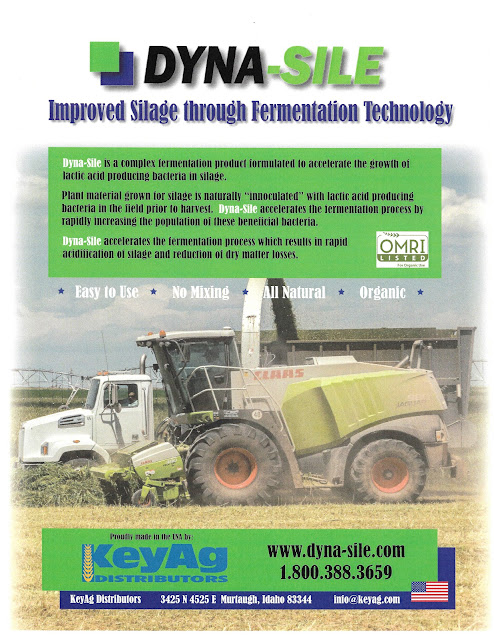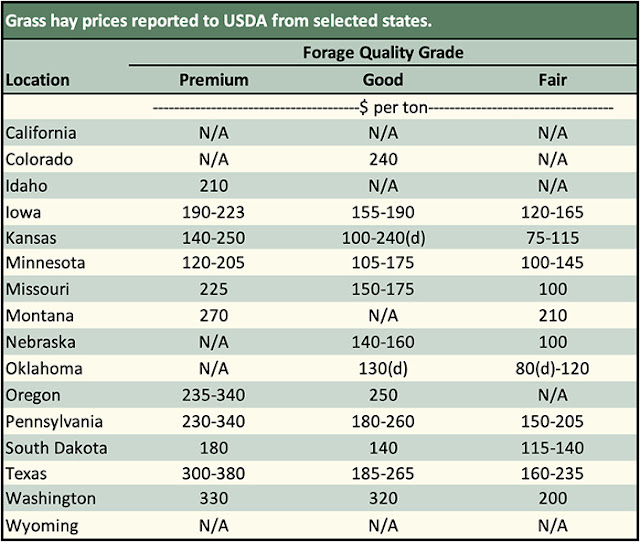Thursday, February 29, 2024
Wednesday, February 28, 2024
Tuesday, February 27, 2024
Monday, February 26, 2024
State-By-State Hay Summary
Colorado—In the Feb. 15 report, trade activity light on moderate demand. Retail and stable hay sold steady.
Missouri—In the Feb. 15 report, compared to last report, the supply of hay is light to moderate, demand is moderate to good, and prices mostly steady. Weather was mixed and warmer than average, with some areas still showing various stages of drought. Despite that status it is pretty muddy in lots and in places trying to feed and it is still pretty easy to get stuck if one isn’t aware of the spots that stay wet. Although there is still plenty of feeding days left many farmers are thinking about fertilizer now and lots are out checking prices if they haven’t already pre-bought. Data suggests prices lower than last year.
Nebraska—In the Feb. 15 report, compared to last report, hay sales sold steady. Demand was mostly light. Reports of quite a lot of bales of hay still available for sale in a large area. Many producers are having a hard time grasping why the hay market is stagnate this year. A few notes on possibly why, per NASS beef cow inventory as of Jan 1 in Nebraska is down nearly 70,000 head, mostly open winter where cattle can graze and are not having to be supplemented large amounts of forage and many backgrounding lots are not at capacity. Also, many cattle suited for wheat grazing have headed south out of the state. All reasons why there are not as many mouths eating the bales of forage within this state.
Oklahoma—In the Feb. 16 report, compared to the last report, the demand remains low and most of our hay producers are still not trading much hay and only delivering to long-time customers. Next report will be released March 1.
Texas—In the Feb. 9 report, hay prices are mostly steady. Hay is getting more scarce to come by, but buyer demand hasn’t been as prominent this year due to a milder winter in all regions. The milder winter coupled with some timely moisture has aloud winter grazing to sustain producers in some regions longer this year, allowing them to feed less. First cutting of hay in the south will usually be marketed by the end of March or first of April. Next report will be released Feb. 23.
South Dakota—In the Feb. 16 report, compared to last report, alfalfa hay steady to weak. Moderate demand for dairy quality alfalfa as low milk prices are pressuring margins for dairy operators causing them to cut cost where they can. Good demand for grass hay and for corn stalks. Ground conditions firmed back up after the freezing and thawing cycle, along with some sunshine this week, but snow was back at Midweek in parts of the state. Warmer temps in the forecast for next week, 50 degrees plus.
New Mexico—In the Nov. 24, 2023 report, compared to last report, alfalfa hay steady. Trade active, demand good. The the state is 73% complete with fifth cutting, 54% with sixth cutting. Most parts of the state are wrapping up harvest for the season. According to New Mexico Crop Progress report as of Nov. 12, 2023. Hay and roughage supplies improved slightly from the previous week but remained in worse condition than prior years. Hay and roughage supplies were observed to be 25% very short, 42% short, 30% adequate, and 3% surplus. At 14% very short, 37% short, 45% adequate, and 4% surplus, stock water supplies were on par with the 5-year average. This is the last report for the season, reports will resume in spring 2024.
Wyoming—In the Feb. 15 report, compared to last report, bales of hay sold steady. Sun-cured alfalfa pellets sold $10 lower. Overall demand for hay is very light. Mostly open winter, less beef cows in the state along with heavy supply of hay in a several state area has made most hay sales inactive. Several contacts are afraid they will have old crop hay still in the barn when the first alfalfa hits the swather. This is the first time in a while that has happened.
Montana—In the Feb. 16 report, compared to last report, hay sold fully steady. Hay sales were light again this week, however demand for some classes improved. Finding good, or higher quality is proving difficult as much of the hay on the market is fair and lower in quality. High test hay is very short and buyers continue to search for high test hay, practically for dairy use. The upper end of feeding quality hay has seen some improvement in demand as dairies are buying hay with relative feed values as low as $155 for dairy usage due to the shortage of test hay. Demand for feeder quality hay remains very light with very heavy supplies seen, especially in central Montana. Many buyers report interest has improved to buy hay to carry over in case of a drought or for next winter. However, very few actual sales have been reported for this purpose. The best demand for feeder quality (utility and fair) hay is around $150/ton delivered. Many producers seem content with having some carry over this year. Demand for straw is light as heavy straw supplies continue to be seen especially in the northern portion of the state. Single load sales continue to move at steady money from time to time, however many producers have lowered asking prices in an attempt to move volume as supplies remain high. Volume sales sold lower in a narrow comparison.

-page-001.jpg)
-page-002.jpg)
-page-003.jpg)

-page-001.jpg)
-page-002.jpg)

-page-001.jpg)
-page-002.jpg)

-page-001.jpg)
-page-002.jpg)
-page-003.jpg)
-page-004.jpg)
-page-005.jpg)
-page-006.jpg)
-page-007.jpg)
-page-008.jpg)

-page-001.jpg)
-page-002.jpg)

-page-001.jpg)
-page-002.jpg)




-page-001.jpg)






-page-001.jpg)

-page-001.jpg)

-page-001.jpg)
-page-002.jpg)
-page-003.jpg)

-page-001.jpg)

-page-001.jpg)
-page-002.jpg)
-page-003.jpg)

-page-001.jpg)
-page-002.jpg)
-page-003.jpg)
